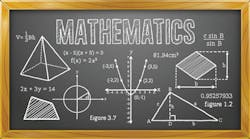Electrical work often involves applying algebra, trigonometry, and geometry. We use these to calculate all sorts of things, from raceway fill and box fill to bend angles. In a previous era, it was common to see math problems scrawled out in pencil on unfinished drywall or other surfaces on the construction site.
Today, it’s increasingly common to use an app for that. You may make a stupid, silly mistake when figuring by hand. We’ve all done it, slapped out foreheads, and gotten some ribbing from co-workers. What can possibly go wrong with an app?
Well, you could easily tap the wrong item on the screen. You can enter the wrong number or perform the wrong operation. A mistake is just a finger swipe or virtual button click away. One danger here is you get a number and don’t realize it’s wrong.
And there’s no problem worked out on the wall for someone else to, after laughing hysterically, let you know that you’d better not put that 1/2-in. conduit in the bender just yet. “Seriously, it’s not going to hold 10 number two conductors. Did you forget your coffee this morning?”
A more pernicious danger is that as you increasingly rely on apps, you lose the ability to visualize the work.
Mathematics is really a way of thinking. For example, geometry helps us think about how things relate proportionately to each other. If you don’t use it, you lose it, and mathematical ability is no exception.
Does this mean you shouldn’t use apps? Not at all. Just as that co-worker quickly calculated the numbers you left on the wall and realized your answer was wrong, an app can serve that same function — without the ribbing and laughter.
So work out the problem to keep your math abilities sharp. Then use an app to check the answer. If there’s a difference, don’t just go with the app (it may be wrong). Whether you have an app or not, always do a reality check on your answer (you could get it wrong twice, which would be really embarrassing). Errors tend to be gross errors, and you can use that fact to your advantage.
For example, you calculated the volume of a box. Recall that area is length times width and volume is area times height or depth.
Let’s say the box is 8 x 8 x 6. You know your squares pretty well, so you know that 8 x 8 is 64. Your volume calculation is 192. Can that possibly be right? If you round 64 down to 60, you have an easy number to work with mentally. You know that 6 x 3 is 18, so 60 times 3 is 180. No way is 192 correct. It’s only about half as large as the answer should be.
This kind of error would most likely occur when using an app, because the 6 and the 3 are typically adjacent (on keypads and 10-key displays), and it’s easy to accidentally select the wrong one.
What about geometry? A key principle here is visualization. You need to be able to “see” the angles you’re talking about. If you can’t do that in your head, draw them out. Suppose your app says the bend should be 270°. If you draw this and rotate your drawing, you’ll see it’s a 90° bend. You should be able to do this in your head.
One more example illustrates visualization. Before the days of digital clocks, we used the clock face position to indicate direction. “Look at three o’clock” meant to look 90° clockwise from where you were. Old-timers still use this, but many younger people find it mystifying because they don’t use an analog clock and can’t visualize this.
You need to actually work with numbers to get (and keep) a feel for what’s right and what’s not. Use apps not as a crutch or substitute, but as another “set of eyes” on the problem. And remember, the typical app can’t draw things out but you can. Keep that pencil handy!
About the Author

Mark Lamendola
Mark is an expert in maintenance management, having racked up an impressive track record during his time working in the field. He also has extensive knowledge of, and practical expertise with, the National Electrical Code (NEC). Through his consulting business, he provides articles and training materials on electrical topics, specializing in making difficult subjects easy to understand and focusing on the practical aspects of electrical work.
Prior to starting his own business, Mark served as the Technical Editor on EC&M for six years, worked three years in nuclear maintenance, six years as a contract project engineer/project manager, three years as a systems engineer, and three years in plant maintenance management.
Mark earned an AAS degree from Rock Valley College, a BSEET from Columbia Pacific University, and an MBA from Lake Erie College. He’s also completed several related certifications over the years and even was formerly licensed as a Master Electrician. He is a Senior Member of the IEEE and past Chairman of the Kansas City Chapters of both the IEEE and the IEEE Computer Society. Mark also served as the program director for, a board member of, and webmaster of, the Midwest Chapter of the 7x24 Exchange. He has also held memberships with the following organizations: NETA, NFPA, International Association of Webmasters, and Institute of Certified Professional Managers.

